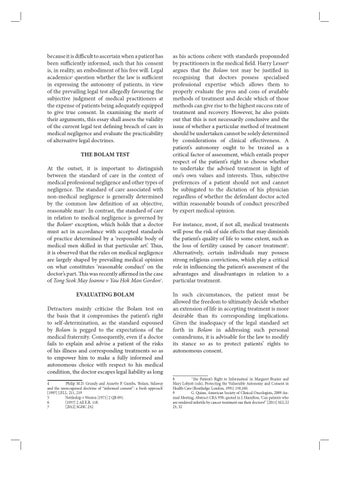because it is difficult to ascertain when a patient has been sufficiently informed, such that his consent is, in reality, an embodiment of his free will. Legal academics4 question whether the law is sufficient in expressing the autonomy of patients, in view of the prevailing legal test allegedly favouring the subjective judgment of medical practitioners at the expense of patients being adequately equipped to give true consent. In examining the merit of their arguments, this essay shall assess the validity of the current legal test defining breach of care in medical negligence and evaluate the practicability of alternative legal doctrines. THE BOLAM TEST At the outset, it is important to distinguish between the standard of care in the context of medical professional negligence and other types of negligence. The standard of care associated with non-medical negligence is generally determined by the common law definition of an objective, reasonable man5. In contrast, the standard of care in relation to medical negligence is governed by the Bolam6 exception, which holds that a doctor must act in accordance with accepted standards of practice determined by a ‘responsible body of medical men skilled in that particular art’. Thus, it is observed that the rules on medical negligence are largely shaped by prevailing medical opinion on what constitutes ‘reasonable conduct’ on the doctor’s part. This was recently affirmed in the case of Tong Seok May Joanne v Yau Hok Man Gordon7. EVALUATING BOLAM Detractors mainly criticise the Bolam test on the basis that it compromises the patient’s right to self-determination, as the standard espoused by Bolam is pegged to the expectations of the medical fraternity. Consequently, even if a doctor fails to explain and advise a patient of the risks of his illness and corresponding treatments so as to empower him to make a fully informed and autonomous choice with respect to his medical condition, the doctor escapes legal liability as long 4 Philip M.D. Grundy and Annette P. Gumbs, ‘Bolam, Sidaway and the unrecognised doctrine of “informed consent”: a fresh approach’ [1997] J.P.I.L. 211, 219 5 Nettleship v Weston [1971] 2 QB 691. 6 [1957] 2 All E.R. 118. 7 [2012] SGHC 252.
as his actions cohere with standards propounded by practitioners in the medical field. Harry Lesser8 argues that the Bolam test may be justified in recognising that doctors possess specialised professional expertise which allows them to properly evaluate the pros and cons of available methods of treatment and decide which of those methods can give rise to the highest success rate of treatment and recovery. However, he also points out that this is not necessarily conclusive and the issue of whether a particular method of treatment should be undertaken cannot be solely determined by considerations of clinical effectiveness. A patient’s autonomy ought to be treated as a critical factor of assessment, which entails proper respect of the patient’s right to choose whether to undertake the advised treatment in light of one’s own values and interests. Thus, subjective preferences of a patient should not and cannot be subjugated to the dictation of his physician regardless of whether the defendant doctor acted within reasonable bounds of conduct prescribed by expert medical opinion. For instance, most, if not all, medical treatments will pose the risk of side effects that may diminish the patient’s quality of life to some extent, such as the loss of fertility caused by cancer treatment9. Alternatively, certain individuals may possess strong religious convictions, which play a critical role in influencing the patient’s assessment of the advantages and disadvantages in relation to a particular treatment. In such circumstances, the patient must be allowed the freedom to ultimately decide whether an extension of life in accepting treatment is more desirable than its corresponding implications. Given the inadequacy of the legal standard set forth in Bolam in addressing such personal conundrums, it is advisable for the law to modify its stance so as to protect patients’ rights to autonomous consent.
8 ‘The Patient’s Right to Information’ in Margaret Brazier and Mary Lobjoit (eds), Protecting the Vulnerable Autonomy and Consent in Health Care (Routledge: London, 1991) 150,160. 9 G. Quinn, American Society of Clinical Oncologists, 2009 Annual Meeting, Abstract CRA 950; quoted in L Hamilton, ‘Can patients who are rendered infertile by cancer treatment sue their doctors?’ [2011] M.L.J.I 25, 32
